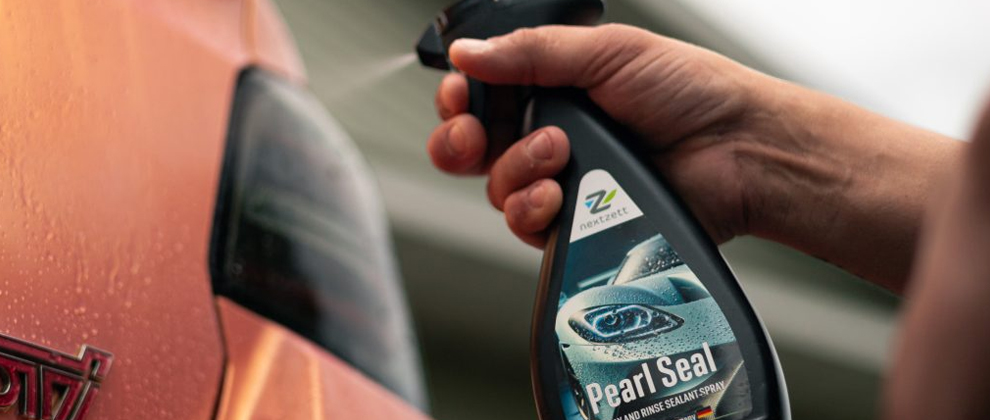While spray-and-rinse sealants may seem like a new technology, they’ve actually been around for quite some time, originating in the carwash industry. For decades, nextzett has been one of Europe’s largest suppliers of carwash products, with expertise in surfactants and polymers, two major components in these products. Spray-and-rinse sealants, used in the final rinse during the drying phase, have only recently made their way into the DIY and prosumer detailing world.
Intro
As detailers, we understand the importance of using the right tools throughout the detailing process, starting with the correct wash mitts and towels. Washing and drying with the proper tools helps prevent marring of the surface. One more tool for the drying phase is the spray-and-rinse sealant.
Polymer-based spray-and-rinse sealants help disperse water, speeding up the drying process and acting as a buffer between the towel and surface, while SiO2-based sealants focus on long-lasting protection and do not act as a drying aid.
In this article, we’ll dive into two popular categories of spray-and-rinse sealants: water-activated polymer rinses and SiO2-based spray-and-rinse sealants.
What Are Water-Activated Polymer Rinses?
Water-activated polymer rinses are designed to activate when they come into contact with water. The polymers bond with water molecules to form a seal on surfaces, including painted finishes, plastic, rubber, and glass.
These rinses are applied to the surface and immediately rinsed off. Upon contact with water, you’ll notice an instant beading effect as water disperses. This beading aids in quicker drying, especially on surfaces that no longer have wax or sealant protection. The water that would otherwise sheet off now beads up, making the drying process easier.
For these reasons, car washes often finish with a polymer-based spray-and-rinse sealant ensuring vehicles, especially those with neglected finishes, dry quickly and leave with a high-gloss protective shine.
What Are SiO2-Based-Spray-and-Rinse Sealants?
SiO2-based spray-and-rinse sealants, also known as ceramic sealants, use silicone dioxide (SiO2) technology, the latest innovation in the car care industry. Like polymer-based sealants, SiO2-based products are applied to a wet surface after the rinse phase of the wash. However, unlike polymer-based sealants, they do not disperse water or act as a drying aid.
SiO2-based sealants create a ceramic-like protective layer, known for its strength and resistance to environmental contaminants. They form a longer-lasting layer of protection and enhanced gloss, which is why they are often used more for their protective qualities rather than as a drying aid.
Key Differences Between Water-Activated Polymer Rinses and SiO2-Based Sealants
Let’s compare the key differences between these two types of spray-and-rinse sealants:
- Composition: Synthetic polymers vs. SiO2 (ceramic technology). While polymers have been around for decades and are tried and tested, SiO2 is the latest innovation with its distinct advantages.
- Application: Both types are easy to use, but polymer-based sealants are slightly easier to apply.
- Durability: SiO2-based sprays last significantly longer-providing protection for several months compared to several weeks for polymer-based sprays.
- Protection and Performance: SiO2-based products provide superior hydrophobicity, UV resistance, and protection against contaminants. While polymer-based rinses are better at aiding the drying process by dispersing water, SiO2 offers more durable protection over time.
- Gloss and Shine: Polymer-based sealants provide immediate shine, while SiO2 products deliver a deeper, longer lasting gloss.
Benefits of Water-Activated Polymer Rinses
- Ease of Application: Simple spray-on, rinse-off process suitable for anyone, regardless of detailing experience.
- Quick Shine: Instant gloss and water repellency make polymer rinses ideal for frequent use.
- Frequent Car Wash Compatibility: Ideal for maintaining vehicles between more substantial treatments like sealant wax or ceramic coatings.
- Cost-Effectiveness: Lower price point compared to SiO2 sealants, making polymer rinses a practical option for regular use.
Benefits of SiO2-Based Spray-and-Rinse Sealants
- Long-Lasting Protection: Typically lasts 3 to 6 months, depending on conditions and usage.
- Ceramic-Like Finish: Provide a deep, glossy shine and a highly slick surface, offering superior aesthetics.
- Advanced Protection: More resistant to chemicals, UV rays, and environmental contaminants than polymer-based products.
How to Choose the Right Product for Your Needs
- For Quick, Frequent Maintenance: Water-activated polymer rinses are perfect for regular use and quick touch-ups.
- For Long-Lasting Protection: SiO2-based sealants are ideal for those seeking more durable protection.
- Consider Your Care Care Routine: Choose the product that matches your washing frequency and desired level of protection.
Can You Use Both?
Absolutely! You can use SiO2-based rinses every 3 to 6 months for long-term protection while applying polymer-based rinses after every wash. This combination allows you to enjoy the benefits of both, complementing each other in your car care routine.
Conclusion
With innovations in the car care industry, achieving a show-car finish is more accessible than ever. Polymer-based spray rinses offer high-gloss shine and sufficient protection at a low cost, while SiO2-based sprays provide longer-lasting, high-quality protection and gloss enhancement.
Polymer-based sealants act as a drying aid by dispersing water, making the drying process quicker, while SiO2-based sealants do not serve as drying aids but offer more durable protection. The choice between them depends on your needs, but both are excellent options for keeping your vehicle looking its best.
